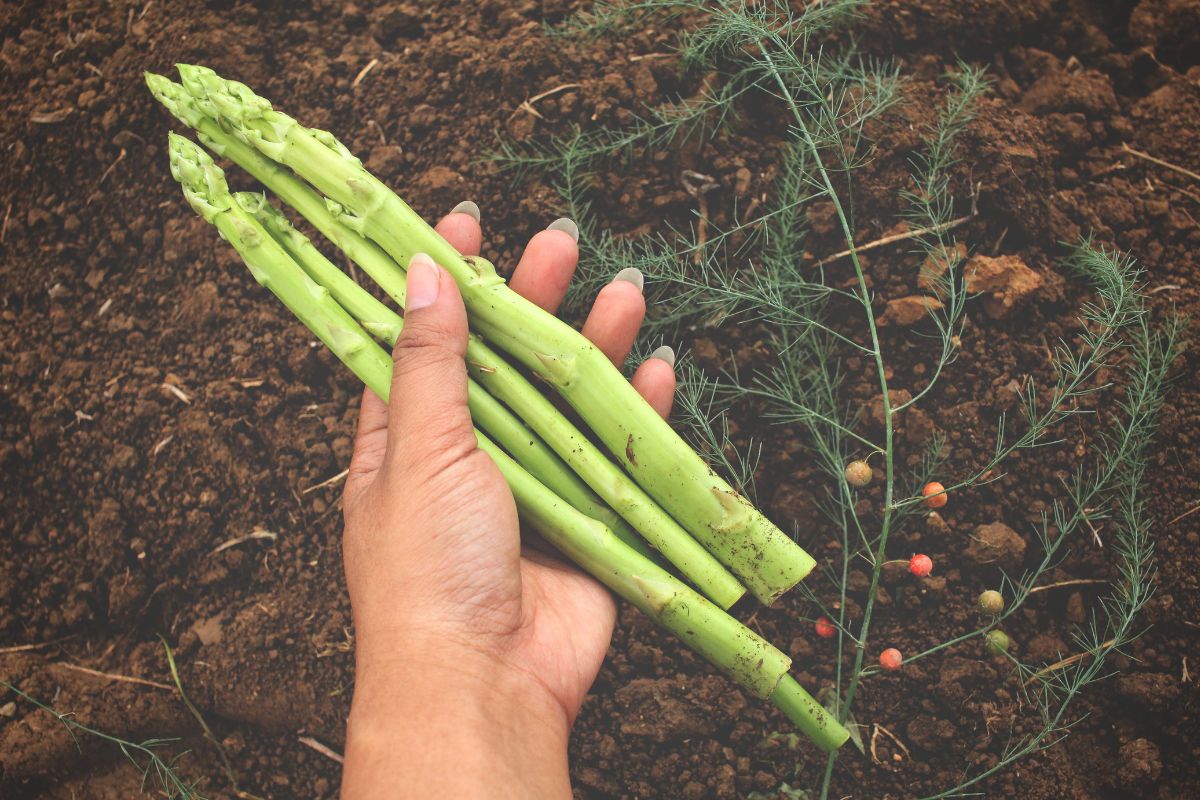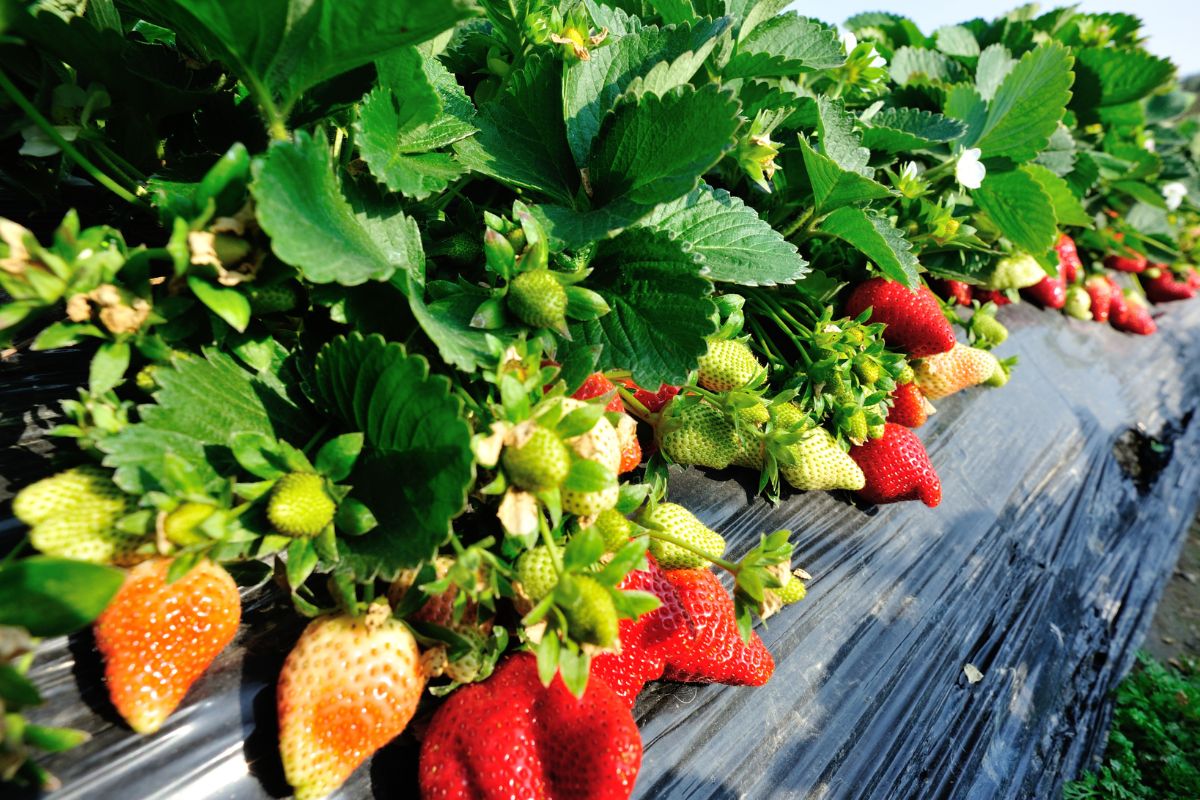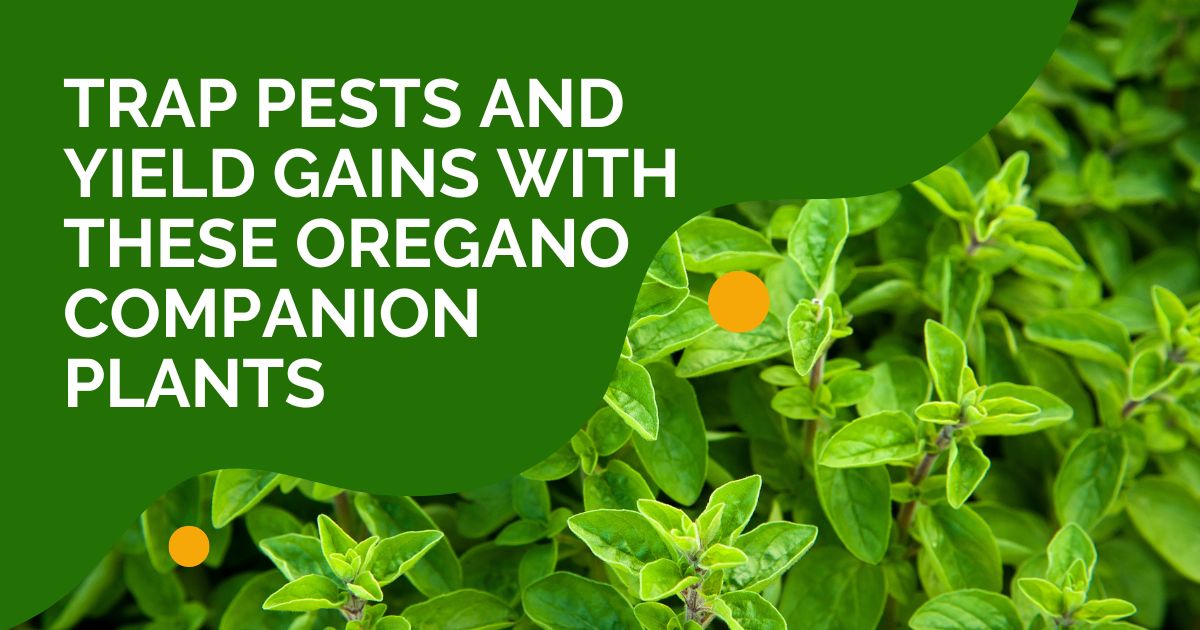Where Does Oregano Come From?
For many years oregano has been one “must-have” herb in the kitchen. Using oregano companion plants can be beneficial to other plants in your garden. While it naturally occurs in several parts of the United States and Mexico, oregano originates from western Asia and the Mediterranean.
Although most people believe oregano can grow with just about anything, there are a few crucial factors to remember. Let’s find out more about companion planting oregano.

Recommended Oregano Companion Plants
Companion planting herbs and flowers is a common practice in both small and large scales. So. What exactly is companion planting? It is the practice of growing various plants adjacent to one another so that they can mutually benefit. From plant to plant, crops can benefit from companion planting differently.
Other plants might gain from an adjacent plant’s ability to deter pests, while some may benefit from sharing the same watering requirements. Companion planting herbs and flowers can make the most of your available area and promote plant growth.
Companion plants for oregano gain more from this herb than the other way around. In a patch with oregano, also known as wild marjoram, plants like beans, capsicum (peppers), and tomatoes will flourish greatly. Oregano plays a significant role in keeping pests at bay and retaining moisture for those plants. It will therefore make a suitable companion plant.
Here are some of the best-recommended oregano companion plants:
Cabbage
Butterflies, worms, and cabbage moths can damage vegetables in the brassica family. These pests are popular with every gardener because they can degrade the quality of the fruit and render it unattractive for consumption or sale.
You only need to place oregano close to your cabbage to eliminate cabbage moths because it repels them. Along with other pests, it will equally destroy cabbage butterflies. This is also true of other cabbage family members, including broccoli and kale.

Tomatoes
While oregano plants do not require a lot of water, tomatoes can grow their roots deeper into the earth to obtain moisture. Their water requirements won’t have to hurt the oregano because of this ability.
Oregano can help tomato plants by protecting them from some pests that could harm them. It can also help keep the soil moist and prevent it from drying up too rapidly, both of which are advantageous to tomato plants.
Rosemary
Like its other family members, sage and thyme, rosemary is a close relative of oregano and is drought-tolerant. The primary aspect that makes it such a great companion plant is that. You can grow both plants in the same area of your garden or container because they require the same amount of water.
Cauliflower
Another vegetable that might be vulnerable to insects and other pests is cauliflower. Oregano can, however, deter these pests thanks to its fragrance. As a result, your cauliflower will thrive in an oregano-filled environment.
In a nutshell, oregano is excellent at warding off bugs and other pests. You won’t have to worry about putting pesticides on your garden, which is one benefit. The oregano will perform the work for you naturally rather than utilizing chemicals that can harm your food to keep bugs away.

Pepper
Oregano pairs well with members of the capsicum family of plants. Plants such as chili and bell peppers grow well with them. They make it taste better, and oregano helps it repel bugs and pests. A blend of oregano and pepper produces great food.
Thyme
Among the available companion plants for herbs, thyme works well as a pest deterrent. Even though oregano serves as a pest deterrent, growing it alongside your oregano will also aid in getting rid of pests.
Thyme enhances the flavor of your oregano plant, and the two go together beautifully in several recipes. Oregano’s presence in your garden deals with those pests and bugs that invade your delicious grapes.
Sage
Sage and oregano grow nicely together since they share similar growing conditions. Sage, for example, prefers dry soil. You can, therefore, lightly water both plants at the same time.
If the two are next, a small amount of water will soak into and spread throughout the soil. As a result, you probably only need to irrigate both plants a tiny bit.
Lavender
Lavender and oregano complement one another well. They both require the same kind of soil to thrive. As a result, the two will work together as a pair of complementary peas.
Squash
Squash bugs are a type of insect that will consume the squash in your garden before you can harvest it and eat it. Oregano can keep these pests away from your squash because they don’t like its aroma.
Asparagus
Planting oregano is impossible without bringing up asparagus. It is nematode-repellent to use this plant. Even if it benefits oregano more than it contributes, it is one of the plants highly suggested for oregano.

Grapes
It is not unexpected that grapes are vulnerable to some pests. This vine plant is not an exception; almost every crop has an adversary. Some examples of these bugs and pests include grape leaf holders and flea bugs.
Cucumber
Squash bugs and cucumber beetles both harm cucumber plants and their fruits. They don’t like oregano because of its harsh scent. Grow oregano alongside cucumbers in the same area to eliminate these pests.
Beans
This crop is similarly vulnerable to pests like aphids and provides a significant amount of nutrients to support the growth of other plants. To get rid of aphids, which rob beans of their nutrients, place oregano close by.
Watermelon
Introduce oregano to your patch if you want your watermelons to produce healthy pollen. Oregano attracts pollinators, which boosts the fruit and productivity of your crops.
Marjoram
Some gardeners mistake marjoram for oregano. Similar to oregano in appearance, marjoram is a member of the mint family. Compared to oregano, it has a stronger scent. The two get along well in the garden and look out for one another.
Strawberries
Many people consider strawberries in their gardens, cereals, and fruit smoothies. Like humans, pests enjoy strawberries. Growing plants that won’t deny it of nutrients is the greatest approach to eliminating these pests, and oregano fits this description perfectly. Grow oregano herb alongside your strawberries to ward off those pests.

Benefits of Oregano Companion Planting
So, how important is companion planting oregano? Using this method in your garden will allow plants to thrive and thrive, which has many advantages. Here are some:
- Your garden will attract pollinators.
- Unwanted pests won’t bother you.
- Easy shade control.
- Increase color and flavoring.
- Easy management of weeds.
To elaborate, oregano has a potent aroma. As a result, it repels some pests, protecting your other plants. However, some pollinators get attracted to it, which will aid in the growth of the other plants.
Oregano can also grow widely. The soil’s limited space constraints weed growth. To ensure that the plants can develop properly, you must take care not to overcrowd your garden.
Oregano can also protect other plants from direct sunlight if that’s not what they require. And finally, oregano can aid in improving the flavor of other plants by boosting their color.
Factors to Consider When Looking for Companion Plants for Oregano
You should make sure that plants you pair together have similar growing requirements. So let’s consider some factors while planting oregano alongside other plants.
Plant Size
Some plants can help one another develop well, which is one reason companion planting benefits your garden. However, there’s a risk the larger plant will take over if it’s next to a smaller one. As a result, it will engulf the smaller plant and hinder its development.
You wouldn’t believe how much space oregano can take up. For instance, oregano can reach a height of two feet and a width of two feet. Oregano can quickly outgrow control and take over greater regions if allowed enough space to grow.
Fortunately, oregano can still serve as a companion plant even if it isn’t exactly next to other plants in the garden. So as not to encroach on any other plants, you can plant oregano in a pot in your garden. It will still be able to fulfill its role as a companion plant.
For instance, oregano will continue to have a potent aroma that will draw pollinators and deter pests.
Growing Conditions
Knowing how to grow each plant is essential while looking for companion plants for oregano. For instance, oregano benefits from sunlight; they’ll therefore need a location in the garden that will receive the most sunlight during the day.
Therefore, you should pick a plant that might also require sunlight. Or you might plant something that doesn’t need a lot of sunshine behind the oregano since it grows rather tall. Oregano will then protect other plants from light.
Another growing environment is water. Most of the time, oregano doesn’t like being wet and doesn’t require much water. Actually, you won’t need to water your oregano again until the ground is completely dry. You can be sure that other plants won’t make a good companion plant for your oregano if they need a lot of water or moist soil.
And lastly, oregano thrives on its own without fertilizer. For this reason, plants that don’t require fertilizer will flourish next to oregano.
How to Use Oregano as a Companion Plant
Here are some key things to keep in mind while using oregano, among other herbs, to give it the best chance of thriving:
- Before transferring the oregano plant’s small seedling to the garden, grow it indoors.
- It would be best if you did not bury the oregano seed deeper than one-quarter inch in the soil.
- Ensure the young oregano plant is grown in a large container before transferring it into the garden.
- Periodically trim your herb’s stems to prevent over-shadowing companion herbs.
- Make sure to place your plant where it will receive direct sunlight.
- Grow your oregano plant in well-drained soil rich in nutrients.
- Always incorporate compost into the soil where you will be growing your plants.
- Because oregano has deep roots, it needs a lot of water to stay moist. Always give your herb plenty of water.
What NOT to Plant With Oregano
Although oregano appears to go well with various vegetables and herbs, you should avoid planting it near plants that require a lot of water. This includes plants like cruciferous veggies that thrive in colder climates. Oregano shouldn’t be grown too close to plants that prefer damp soil. Below are some plants that won’t grow well as oregano’s herb companion:
Basil
Basil is a popular kitchen herb of the Lamiaceae family. Although it is occasionally recommendable as a companion plant for oregano, it has varying watering requirements. Oregano dislikes damp soil, whereas the most popular types of basil do.
Oregano roots can rot in very moist soil, so the success of growing oregano and basil together may rely on the basil species. Choose one that can withstand arid environments.
Chives
Chives, a perennial herb in the Liliaceae family, are grown for their aromatic leaves, which are useful when cooking. The chive plant, related to onions, produces tiny bulbs from the roots. The plant’s hollow, cylindrical, tapering leaves have a velvety touch. Unlike oregano, chives prefer soils with very high moisture levels.
Cilantro
Cilantro comes from the Apiaceae family, including celery, carrots, and parsley, among its other 3,700 species. Although you can eat the entire plant, leaf extracts and dried seeds are the most frequently used ingredients in cooking.
Mint
Mints are members of the Lamiaceae plant family and belong to the genus Mentha. They are grown for their flavorful leaves, which are useful in many dishes. Depending on the kind, mint plants produce a terminal flower spike with either white or purple blooms.
Their leaves have a serrated edge and microscopic hair coating. These mint plants have a rapid rate of growth and can spread widely. This makes them unsuitable planting companions for oregano.
The preferred soil moisture levels for basil, chives, cilantro, and mint are higher than those required for oregano plants. It is advisable to grow these in different containers if you do decide to plant them close together.
That is merely a partial list. Oregano can also withstand colder temperatures, but you shouldn’t plant it next to plants that thrive in the chilly climate. Some plants also like to take over. One of them, for instance, is mint. Mint is an invasive plant that will quickly take over a large portion of the garden if given a chance.
Therefore, if you’re going to grow mint, your best option is to either put it in a pot or place it far enough away from the other plants that it won’t interfere with their growth. Although oregano can spread out fairly well, mint will supplant oregano.
And finally, some plants, like chives and cilantro, require a lot of water to flourish and grow. Since oregano dislikes too much water, it would be all too simple to mistakenly overwater the oregano or not offer enough to the other herbs. Consequently, it stunted one of the plants’ growth.
Frequently Asked Questions
Can Oregano and Basil Be Planted Together?
Some blooming herbs, such as oregano, chives, and chamomile, can be grown adjacent to basil to boost the potency of the essential oils in their nearby herb gardens. Because of this, basil is more flavorful when used in food preparation and works well as a pest deterrent in gardens when used as a companion plant to oregano.
Can You Plant Oregano With Tomatoes?
Yes! You can plant oregano and tomatoes together. These two crops match perfectly when planted close to one another. Due to its fragrant scents, oregano can help keep those bothersome pests and bugs at bay. The tomatoes will gain a great deal from this combination.
What Grows Well With Oregano?
Although there aren’t many plants that don’t get along with oregano, here are some plants and vegetables that benefit the most from being oregano’s companions: Cabbage, thyme, cucumbers, peppers, asparagus, eggplant, rosemary, beans, tomatoes, melons, bee balm, zucchini, carrots, celery, cauliflower, tarragon, grapes, squash, lavender, etc
The Bottom Line
Companion planting for oregano is often not too difficult. Since oregano is a hardy herb, it may be grown everywhere and close to almost anything. So, to aid in the general growth of your garden, place oregano close to several other plants, as discussed in this article.
On the other hand, some plants won’t thrive near oregano (or they’ll cause the oregano to grow less). Plan your companion plants and their placement before you begin gardening. The plants that your oregano should aid will then receive it.
Remember, oregano may easily take over an area since it grows so quickly, similar to how mint can. This is a crucial consideration when choosing oregano as a companion plant. Because of this, it’s a good idea to limit your oregano plants in your yard to a single raised bed or pot.
Use a container of oregano close to the crop for best results because its aroma will keep pests away from your crops, and its flowers will attract helpful insects for pollination.
